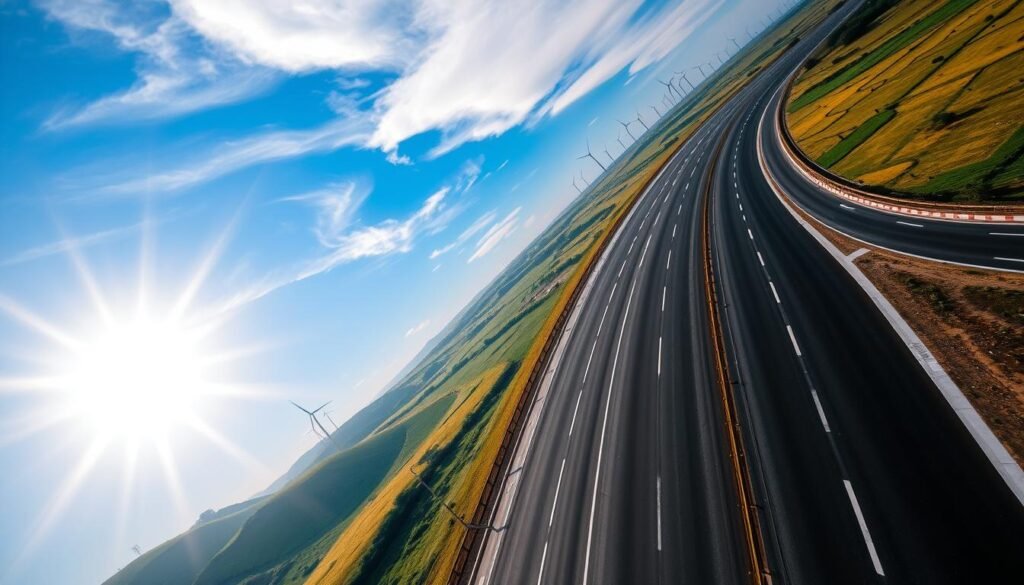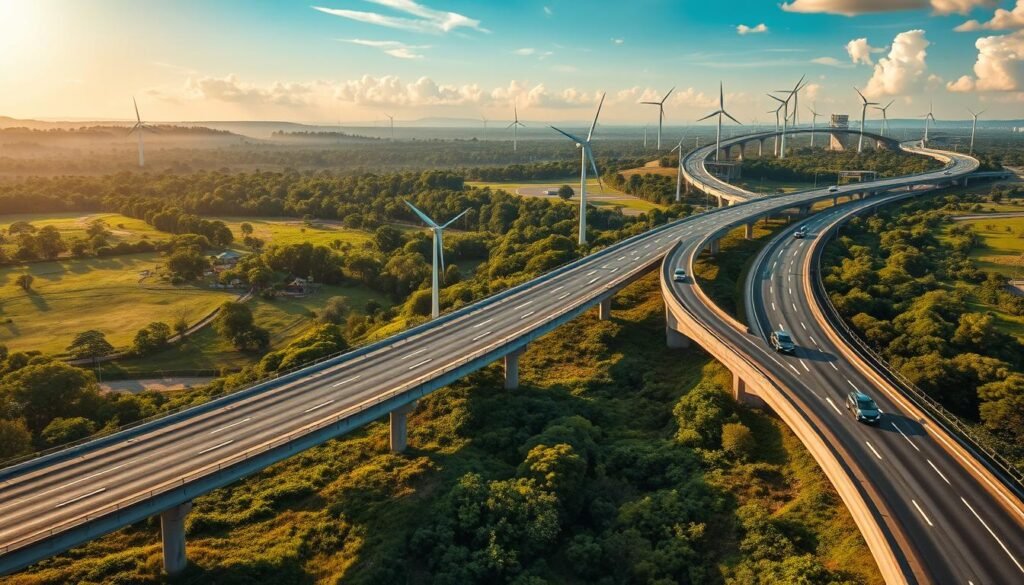India’s highway network is growing fast. A list of expressways is changing how we travel. These roads help connect cities, cut down travel time, and boost the economy.
List of Expressway in india

Building expressways in India has a long history. The government has put a lot of money into these high-speed roads. Now, many cities are linked by these modern highways. Let’s see how expressways affect trade, commerce, and tourism.
Key Takeaways
- India’s expressway network is expanding rapidly, with a growing list of expressway in india.
- The indian expressways list is key for better connectivity and shorter travel times.
- Expressways are helping the economy by making trade and commerce easier.
- The government has invested a lot in these high-speed roads.
- The list of expressway in india is impressive, connecting many major cities.
- Indian expressways are changing the country’s transport scene.
- The impact of expressways on trade, commerce, and tourism is big.
Understanding India’s Expressway Network
India’s expressway network is a complex system of high-speed roads. It connects major cities and towns efficiently. Unlike highways, expressways have controlled access points and grade-separated interchanges.
The expressway network in India started growing in the 1990s. The government has been key in its development. Projects like the National Highways Development Project and Bharatmala Pariyojana aim to improve roads.
- High-speed limits, with some expressways having speed limits of up to 120 km/h
- Controlled access points, which reduce the risk of accidents and improve traffic flow
- Grade-separated interchanges, which reduce congestion and improve safety
- Limited intersections, which reduce the risk of accidents and improve traffic flow
The expressway network is vital for India’s transportation system. It offers safe and efficient travel between cities. As it grows, it will boost the country’s economy, working alongside highways.
Major Operational Expressways in India
India boasts a wide network of major expressways that link cities and regions. These national expressway India routes have cut down travel times, enhanced safety, and spurred economic growth. Key expressways include the Delhi-Gurgaon, Mumbai-Pune, and Chennai-Bengaluru routes.
These major expressways in India offer a fast travel option with multiple lanes and grade separators. They also feature modern safety measures like crash barriers and emergency phone booths. Regular patrols add to the security.
The expressways bring many benefits, like faster travel, better safety, and more economic activity. For example, the Delhi-Gurgaon Expressway now takes just 30 minutes to travel between cities. This has made it a favorite for both commuters and businesses. The Mumbai-Pune Expressway has also boosted connectivity, helping industries and tourism grow.
- Delhi-Gurgaon Expressway: 27.7 km, 8 lanes
- Mumbai-Pune Expressway: 94.5 km, 6 lanes
- Chennai-Bengaluru Expressway: 336 km, 4 lanes
In summary, India’s major expressways have transformed the country’s transport system. They offer a quick, safe, and efficient travel option. The national expressway India is expanding, with new projects underway. These will connect more cities and regions, driving economic growth and development.
The Complete List of Expressway in India
India’s road infrastructure has seen big changes in recent years. The focus has been on making the indian roadways network better. The expressway system is key to this effort, helping millions travel safely and efficiently.
The government has put a lot of money into building new expressways. They want to cut down travel times and boost the economy. With more projects underway, India’s road infrastructure is set to get even better.
- Northern Region: Delhi-Mumbai Expressway, Delhi-Jaipur Expressway
- Southern Region: Bangalore-Chennai Expressway, Hyderabad-Vijayawada Expressway
- Eastern Region: Kolkata-Dhanbad Expressway, Bhubaneswar-Cuttack Expressway
- Western Region: Mumbai-Pune Expressway, Ahmedabad-Vadodara Expressway
These expressways are vital for India’s road infrastructure. They offer faster and more efficient ways to move people and goods. The indian roadways network will keep growing, focusing on safety, sustainability, and economic growth.
Yamuna Expressway: India’s Technology Marvel
The Yamuna Expressway is a key part of India’s growing infrastructure. It shows the country’s skill in building advanced transport systems. As the longest expressway in India, it links major cities, cutting down travel time for people.
This expressway proves India’s dedication to bettering its transport network. It makes India a great place for businesses and tourists.
Some of the key features of the Yamuna Expressway include:
- Advanced traffic management systems to ensure smooth flow of traffic
- State-of-the-art toll collection systems for efficient payment processing
- Emergency response services to provide assistance in case of accidents or breakdowns
The Yamuna Expressway has greatly impacted the area. It has reduced travel time and improved safety. It has also boosted increased economic activity in the region, with businesses growing.
- Length of Yamuna Expressway -165.5 km
- In between Agra to Greater Noida
- 6 Lane which is expandable in 8 Lane
- Emergency call box at every 02km
- Centralized monitoring and control center
- Constructed by Jaypee Group
- Speed Limit is 100 kmph
As India keeps improving its infrastructure, the Yamuna Expressway is a model. It shows how the longest expressway in India can drive growth and development.

Economic Impact of Indian Expressways
Expressways in India have greatly boosted the economy. They have made the transport network better. This has helped industries grow, tourism increase, and regions connect better.
The expressway India in map is now key for businesses and travelers. It makes getting to places easier and cuts down travel time.
Some of the key benefits of Indian expressways include:
- Industrial development along corridors, with many companies setting up manufacturing units and logistics hubs near expressways
- Tourism benefits, with expressways providing easy access to popular tourist destinations and reducing travel time
- Regional connectivity enhancement, with expressways connecting major cities and towns and improving the overall transport network India
Experts say expressways could attract more foreign investment and boost trade. The government’s efforts to improve the transport network are promising.
As India’s economy grows, expressways will become even more important. They help move goods and people, shaping the country’s economic future. Investing in expressways can stimulate growth and enhance the transport network.
Future Expressway Projects Under Construction
India is growing its expressway network fast. Many projects are underway to make travel easier and faster. They aim to boost the economy too.
The Delhi-Mumbai Expressway and the Bengaluru-Chennai Expressway are big ones. They’re set to finish by 2025. This will change how we travel.
These expressways will cut down travel time a lot. They’ll make moving people and goods around the country smoother. This will help the economy grow, opening up new chances for everyone.
- Improved road safety with the use of advanced technology and design
- Increased capacity to reduce congestion and travel time
- Enhanced connectivity between major cities and economic centers
The expressway projects are a big step for India’s future. As they finish, the country will see big changes. It’s an exciting time for India’s roads and economy.
Safety Features and Toll Systems
When it comes to indian expressways list, safety is a top priority. The development of highways in india has led to the implementation of various safety features. These include crash barriers, surveillance systems, and emergency response services. These features are designed to minimize the risk of accidents and ensure a smooth journey for drivers.
The indian expressways list also includes electronic toll collection systems. These systems use advanced technology to automatically deduct tolls from a driver’s account. This eliminates the need for cash transactions. It saves time and reduces congestion at toll booths.
Some of the key safety features and toll systems on highways in india include:
- Advanced surveillance systems to monitor traffic and detect accidents
- Emergency response services to respond quickly to accidents and provide assistance
- Electronic toll collection systems to reduce congestion and reduce congestion
Overall, the safety features and toll systems on indian expressways list are designed to provide a safe and convenient driving experience. By investing in these features, the government aims to reduce accidents and improve the overall efficiency of the transportation network.
Environmental Considerations and Sustainability Measures
The expressway network in India has led to economic growth. But, it also raises concerns about the environment. The national expressway project aims to balance growth with environmental care.
Expressways can cause air pollution from car emissions, noise pollution from traffic, and habitat destruction from land use. To lessen these impacts, the expressway network is using green corridors and eco-friendly materials.
Key sustainability steps include:
- Green corridors to cut down air pollution
- Solar-powered toll systems to lower carbon emissions
- Eco-friendly construction materials to reduce waste

The national expressway project wants to lessen its environmental harm while boosting the economy. By using green measures, the expressway network can protect the environment. This will help create a better future for all.
Conclusion: The Road Ahead for Indian Expressways
India’s expressways have changed the way we travel. They have made the country’s roads better and faster. The Yamuna Expressway is a great example of this.
These roads have helped the economy grow and connect different parts of the country. They also make it easier to travel and do business. This is good for everyone.
The government wants to make even more expressways. This will help industries grow and attract more tourists. It will also make the country’s roads safer and better for the environment.
India is looking forward to a brighter future with its expressways. They will make the country more connected and prosperous. The work on these roads shows India’s dedication to progress and excellence.
FAQ
What is the definition of an Indian expressway?
An Indian expressway is a special highway for fast travel. It has fewer access points and is built for high speeds. This makes it different from regular highways.
How do expressways differ from highways in India?
Expressways and highways in India have key differences. Expressways have fewer access points and higher speed limits. They also have better safety features. Highways, on the other hand, allow more local traffic and have lower speed limits.
What is the history of expressway development in India?
Expressway development in India started in the 1990s. The first expressway was the Mumbai-Pune Expressway. Now, India has many expressways, like the Delhi-Gurgaon and Yamuna Expressways.
What are some of the major operational expressways in India?
Major expressways in India include the Delhi-Gurgaon and Mumbai-Pune Expressways. Also, the Chennai-Bengaluru, Yamuna, and Noida-Greater Noida Expressways are operational.
What are the key features of the Yamuna Expressway?
The Yamuna Expressway is a technological marvel. It has advanced safety systems like cameras and emergency call boxes. It also uses electronic toll collection and has a dedicated emergency response system.
How have Indian expressways impacted the country’s economy?
Indian expressways have positively impacted the economy. They have spurred industrial growth and boosted tourism. They also improve regional connectivity, leading to more economic activity.
What future expressway projects are currently under construction in India?
India is building several expressways, like the Delhi-Mumbai and Bangalore-Chennai Expressways. These projects aim to expand the highway network and improve connectivity.
What safety features and toll systems are implemented on Indian expressways?
Indian expressways have safety features like crash barriers and surveillance systems. They also use electronic toll collection systems. This makes payment easier and reduces congestion.
